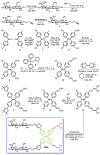An AIE-Active NIR Fluorescent Probe with Good Water Solubility for the Detection of Aβ1-42 Aggregates in Alzheimer's Disease
- PMID: 37446772
- PMCID: PMC10343367
- DOI: 10.3390/molecules28135110
An AIE-Active NIR Fluorescent Probe with Good Water Solubility for the Detection of Aβ1-42 Aggregates in Alzheimer's Disease
Abstract
Alzheimer's disease (AD), an amyloid-related disease, seriously endangers the health of elderly individuals. According to current research, its main pathogenic factor is the amyloid protein, which is a kind of fibrillar aggregate formed by noncovalent self-assembly of proteins. Based on the characteristics of aggregation-induced emission (AIE), a bislactosyl-decorated tetraphenylethylene (TPE) molecule TMNL (TPE + malononitrile + lactose), bearing two malononitrile substituents, was designed and synthesized in this work. The amphiphilic TMNL could self-assemble into fluorescent organic nanoparticles (FONs) with near-infrared (NIR) fluorescence emission in physiological PBS (phosphate buffered saline), achieving excellent fluorescent enhancement (47-fold) upon its combination with Aβ1-42 fibrils. TMNL was successfully applied to image Aβ1-42 plaques in the brain tissue of AD transgenic mice, and due to the AIE properties of TMNL, no additional rinsing process was necessary. It is believed that the probe reported in this work should be useful for the sensitive detection and accurate localization mapping of Aβ1-42 aggregates related to Alzheimer's disease.
Keywords: AIE; Alzheimer’s disease; Aβ; amyloid; fluorescence; lactose; near-infrared imaging; tetraphenylethylene.
Conflict of interest statement
The authors declare no conflict of interest.
Figures











Similar articles
-
Engineering of donor-acceptor-donor curcumin analogues as near-infrared fluorescent probes for in vivo imaging of amyloid-β species.Theranostics. 2022 Apr 4;12(7):3178-3195. doi: 10.7150/thno.68679. eCollection 2022. Theranostics. 2022. PMID: 35547754 Free PMC article.
-
NIR fluorescent probes with good water-solubility for detection of amyloid beta aggregates in Alzheimer's disease.J Mater Chem B. 2019 Sep 18;7(36):5535-5540. doi: 10.1039/c9tb01012b. J Mater Chem B. 2019. PMID: 31451829
-
Evaluation of N, O-Benzamide difluoroboron derivatives as near-infrared fluorescent probes to detect β-amyloid and tau tangles.Eur J Med Chem. 2022 Jan 5;227:113968. doi: 10.1016/j.ejmech.2021.113968. Epub 2021 Oct 31. Eur J Med Chem. 2022. PMID: 34752954
-
Advances in fluorescent probes for detection and imaging of amyloid-β peptides in Alzheimer's disease.Adv Clin Chem. 2021;103:135-190. doi: 10.1016/bs.acc.2020.08.008. Epub 2021 Feb 15. Adv Clin Chem. 2021. PMID: 34229849 Review.
-
Versatile fluorescent probes for near-infrared imaging of amyloid-β species in Alzheimer's disease mouse model.J Mater Chem B. 2019 Mar 28;7(12):1986-1995. doi: 10.1039/c9tb00161a. Epub 2019 Mar 1. J Mater Chem B. 2019. PMID: 32254802 Review.
Cited by
-
Ligands for Protein Fibrils of Amyloid-β, α-Synuclein, and Tau.Chem Rev. 2025 Jun 11;125(11):5282-5348. doi: 10.1021/acs.chemrev.4c00838. Epub 2025 May 6. Chem Rev. 2025. PMID: 40327808 Free PMC article. Review.
References
MeSH terms
Substances
Grants and funding
LinkOut - more resources
Full Text Sources
Medical
Miscellaneous

